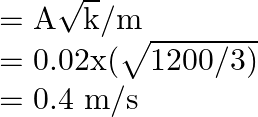
Determine the maximum speed of the mass.
Solution:
Spring constant is given as ![]()
Mass is given as ![]()
Displacement is given as ![]()
![]()
Maximum velocity is given as ![]()
On substituting the values we get,

As a result, the maximum velocity of the mass is ![]()

Determine the maximum speed of the mass.
Solution:
Spring constant is given as ![]()
Mass is given as ![]()
Displacement is given as ![]()
![]()
Maximum velocity is given as ![]()
On substituting the values we get,

As a result, the maximum velocity of the mass is ![]()